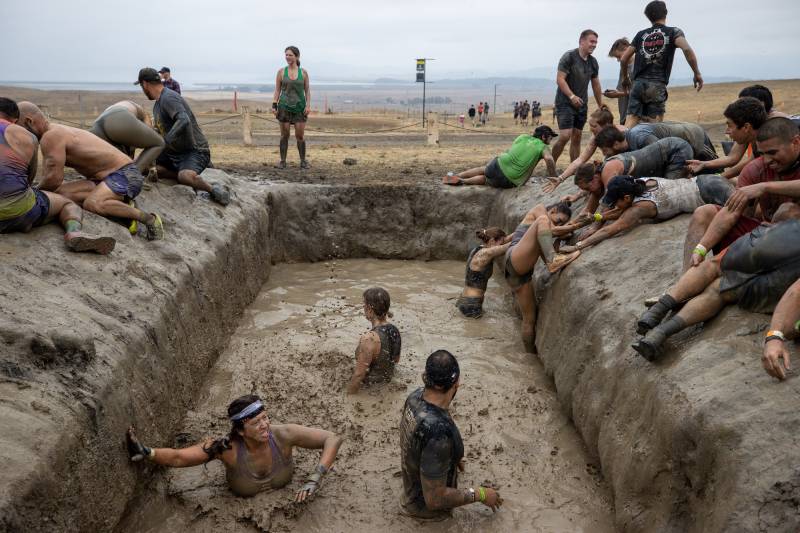Most of the people who did the Tough Mudder in Sonoma are recreational athletes, who do it with friends, and mix it in with marathons or CrossFit classes.
Michelle Spinosa said this year’s event was her second one. “I got two soccer moms to do this with me and we did the full 9-mile event,” she said, joking that they were over 10 years older than most of the men around them.
Because Spinosa works in public health, she said she had signed up for the first time-slot at the start of the day — thinking it would simply be less gross than going after the sun beat down on thousands of bodies crawling through mud. (A tactic I also adhere to.)
“I knew that could happen,” Spinosa said of the infection risk, although she emphasized that despite the unintended outcome it still seemed like a well-run event. “I don’t think this was any more gross than any other of these events.”
A big part of the appeal, she said, is the camaraderie as you work with other people to overcome obstacles, some of which by design cannot be completed without help. “You’re working with strangers to accomplish something that’s gross and hard.”
Wait, what?! Why do people do Tough Mudder and obstacle course races?
Because jumping into mud pits is fun!
“There’s something really empowering, too,” about knowing you can do these challenging things, Spinosa said.
Tough Mudder, historically, has billed itself as a way to push people’s boundaries and help them find out what they’re capable of. There’s a whole shelf of research (CGI) that’s been hotly discussed about why this particular brand of what’s known as Type II fun is especially popular among white-collar workers. But it doesn’t take much theorizing to realize there’s some innate appeal to getting muddy with your friends and climbing over a log.
“There are two main reasons people do these,” said Erin Beresini, author of the book Off Course: Inside the Mad, Muddy World of Obstacle Course Racing. One is the physical challenge, she said. “Where everything in life has gotten so easy, there’s this primal need to be challenged physically that they’re not getting in their every day.”
The second reason is the camaraderie. Bonds formed in that challenge, she said, tend to be stronger and form faster.
Personally, having done a half-dozen OCRs, I’ve always found the Spartan Races more interesting, because they’re less about inflicting pain and more about the actual physical obstacles. But, as the sport has developed, they’ve also become more challenging and require more training and skill, compared to Tough Mudder races. It doesn’t take too much training to crawl through mud — hence their appeal.
What if I have an infection?
Sonoma County health officials are urging anyone with symptoms to see a doctor or, if you don’t have a primary care provider, to go to your local emergency department.
Testing and investigations are still being done to figure out whether the outbreak was caused by staph — which can be carried by other humans — or a bacteria, like Aeromonas, found in the mud and water. There are lots of different kinds of possible bacteria in muddy water, noted Young, the infectious disease expert, and runoff from nearby cow pastures in Sonoma could certainly contribute.
But Aeromonas, which has already been detected in a number of participants, is believed to be the main culprit.
“These bacterial infections can develop when skin is exposed to soils and mud,” county health officials said in its letter to participants. “If untreated, serious illness and sepsis can develop.”
What is Aeromonas and how common is it?
Aeromonas hydrophila is a type of bacteria that’s found naturally in mud and warm fresh and brackish water — meaning it isn’t necessarily the result of contamination or human influence. It’s found in North America, as well as in other parts of the world, said Young — especially warmer areas, like in Florida — and may be emerging as climate change warms waters.
It’s relatively ubiquitous in fish, reptiles and mammals, and can lead to gastrointestinal distress. But an outbreak like this is pretty uncommon. “It’s just bad luck,” Young said, while noting there is always a risk, especially when people may have open cuts or have to submerge themselves.
As with almost all forms of bacteria, there are a few documented cases of incredibly rare severe drug-resistant infections.
Are there any regulations on these kinds of races?
Yes, and no. Largely, the extent of the regulations depend both on where the race is held and what the event’s insurance provider requires. Florida, for example, allowed one of the first COVID-era mass participation races to come back with a 1,000-person Spartan Race in June 2020 — at a time when most states and municipalities were still refraining from permitting events of that nature.

